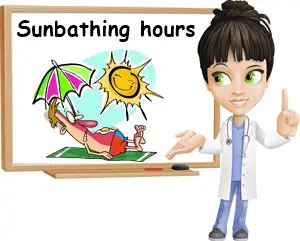Sunbathing isn’t only about getting a beautiful tan. It’s about becoming healthier as well because sun exposure triggers the production of vitamin D, a nutrient with a huge positive impact on our health. Nevertheless, inadequate exposure to sunlight can pose serious health risks, especially at certain hours when the ultraviolet radiation is at its peak and can cause long term side effects.
Most people usually know how to enjoy sun exposure in a relatively healthy manner, in the sense that they acknowledge the importance of sunscreen and sunblock use as well as know when it’s the best and worst time to go outside in the sun. Nevertheless, not everyone knows what the best and worst sunbathing hours are and why, or why it is so important that we stick to experts’ recommendations when it comes to sun exposure and when and how to enjoy it.

What are the benefits of sun exposure?
Sunbathing is first and foremost about vitamin D production and its highly beneficial effects on physical and mental health. Vitamin D synthesized as a result of sun exposure is proven to boost immunity and perfect the immune system response, strengthen bones and teeth, preventing rickets, osteopenia and reducing risks of osteoporosis.
Both exposure to sunlight and vitamin D produced from sun exposure help alleviate joint pain, muscle pain and muscle aches, as well as boosting mental health and improve mood. Vitamin D is known to be involved in regulating circadian rhythms and improving sleep patterns, helps relieve insomnia and reduce the prevalence and side effects of seasonal affective disorder (SAD). Vitamin D production is highly dependent on sufficient and adequate sun exposure that encourages our skin to produce the nutrient. Neither too much nor to little sun exposure are good for us.
What is the best time for sun exposure?
The best time for sun exposure depends not only on the time of day, but also on the time of year, geographical coordinates, weather conditions (is it cloudy or is it a clear sky?) as well as skin particularities such as content of melanin, sunscreen or sunblock use, clothing choice etc. Considering this wide variety of factors that influence the intensity/amount of ultraviolet radiation reaching our skin, safe sunlight exposure hours may not be the same for everyone across the globe. With this in mind, it may be necessary to sometimes adapt your sun bathing hours to factors such as skin type, weather conditions or geographical location to avoid potential side effects such as sun burns or increased risks of skin cancer.

How to sunbathe correctly: tips and advice
By taking into consideration the following factors and variables, you can practice safe sun exposure, and enjoy the benefits for health that come with it while minimizing associated risks and side effects.
Best time of day and time of year for sun exposure
Experts say that, generally, sunbathing is safest during summer before 11 a.m. and after 3-4 p.m. In other words, we have to avoid sunbathing in the middle of the day, when the sun is scorching hot (or when the shadow is shorter than our height). By avoiding this time span, we reduce our risk of getting sunburns and skin damage that may favor the development of skin cancer.
Nevertheless, there are those who tell us to go out in the scorching midday sun during summer because that’s when we get the best tan and enjoy more of the good type of ultraviolet radiation that helps our skin produce more vitamin D. But it’s not healthy for us to sunbathe in the middle of the day when we feel our skin too hot for comfort after only 10-15 minutes in the sun.
At this point, no amount of sunscreen or sunblock can protect us from sun damage. And there isn’t really a good type of ultraviolet radiation because UVA, UVB and UVC (though the third does not really pass through the atmosphere), despite favoring physical and mental health, have carcinogenic effects.
Moreover, getting our vitamin D from sun exposure is a process in itself, one that requires constant exposure over short periods of time throughout hot summer days. Going outside for a short 30-40 minute walk or an errand during summer, while wearing short pants, short sleeves and a hat is enough exposure to help us produce significant amounts of vitamin D.
Things are a bit different during wintertime in the the northern hemisphere. Because of the cold weather and lack of sunlight, the best time to get a little sun is the middle of the day. And considering that low temperatures might not allow for short sleeves or short pants, we have to make sure we at least get some sun on our face and hands and further supplement to meet our daily needs.
Weather conditions for sun exposure
Sometimes, summer doesn’t feel or look like summer and winter doesn’t feel or look like winter either. Rainy days do not allow for any proper sun exposure, while cloudy skies don’t help us produce much vitamin D. For example, if it’s cloudy outside, then sunlight and sun radiation may not reach us at all (the cloudier it is, the less sun we enjoy).
This means that enjoying some sun during the middle of a not-so-hot summer day is equivalent to sunbathing during the safe hours of a scorching hot day. We kind of have to adjust to the weather conditions during each season and try to guess the safest sunbathing hours according to the level of comfort we think we might experience after spending 10-15 minutes in the sun.
Skin content of melanin and sun exposure risks and benefits
A crucial point to consider when sunbathing in general is our skin’s melanin content. Basically, the darker the skin, the more melanin it has. The lighter the skin, the less melanin it has. What is melanin? Melanin is a pigment that protects our skin from excessive sunlight radiation, but, at the same time, has the ability to block vitamin D production.
The more tanned our skin gets, the more melanin it concentrates and the less vitamin D it produces. This, however, does not necessarily mean that people with darker skin have a vitamin D deficiency or that people with fair skin produce too much of the nutrient. But it does indicate how our skin is most likely to respond to sun exposure and regulate vitamin D production.
Find out more scientific facts about melanin.
What is interesting is that people with darker skin are more responsive to sun exposure. For example, a person with darker skin is more likely to get tanned faster, often without sunburns (provided the exposure is moderate) and require less sun exposure and protection for it than a person with fair skin.
A person with fair skin might need an overall lengthier sun exposure for similar health benefits, but will tend to get sunburns faster, tan very little or not at all, and require shorter, but more numerous sunbathing sessions. While a person with fair skin should always use sunscreen and absolutely avoid midday hours, a person with darker skin might linger 20 more minutes in the sun without worrying.
Discover the benefits of melanin.
Use of sunscreen or sunblock and clothing choice
Experts advise everyone to use sunscreen or sunblock and remember to reapply it at regular intervals, after coming out of the water or using a towel to dry up. Fair-skinned people are the most sensitive because their low melanin content leaves them more exposed to sunburns and skin damage.
Sunscreen and sunblock are crucial in cases of prolonged exposure to sunlight, even during the safe hours. But by blocking sun radiation, SPF lotions block vitamin D production as well.
This is where clothing choice becomes important.
We can get our 20 minutes or so of sun and produce some vitamin by unintentionally exposing our arms, hands, part of our legs and face. Going to the store down the street for some snacks, having a lemonade on the porch in the morning or afternoon and other similar activities that do not require a bathing suit, but rather shorts and short sleeves can get us some sun exposure during summer without having to lather ourselves in sunscreen.
Geographical coordinates and sun exposure
Where we live (or sunbathe) can influence the amount of sunlight radiation the earth receives and our skin absorbs. The closer we are to the Equator, the more sun we enjoy and the more likely we are to experience the side effects of too much or inadequate sun exposure. In the mid-latitudes, exposure is problematic only during summer, when it’s best to avoid midday hours. The farther south we go, the more sunlight and warmth there is and the more important safe sunbathing hours become.
Age and state of health and sun exposure
There is great emphasis on children and the elderly getting enough sun to help with bone development and strength and good immunity. But the truth is we need to take in sufficient sun at all ages. It’s only that adults are believed to already be aware of the importance of sun exposure and get their time in the sun, as opposed to children or the elderly who may not be in the position to enjoy proper sun exposure without guidance or help.
Moreover, it has been shown that sun exposure is particularly beneficial for those in poor health as a result of the immune-boosting effects of vitamin D. Nevertheless, keeping to safe sunbathing hours remains important, particularly for those who are already at risk for skin conditions such as melanoma.
